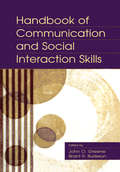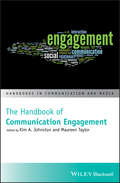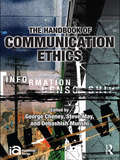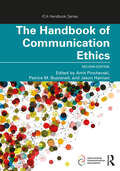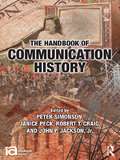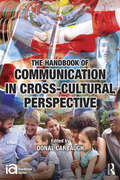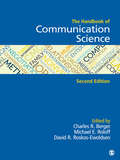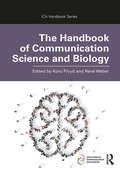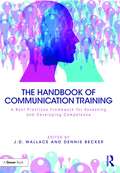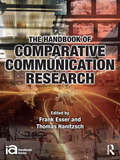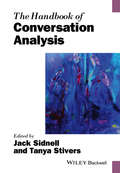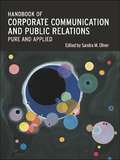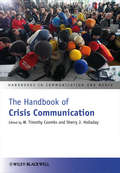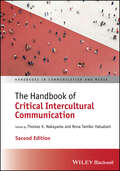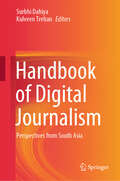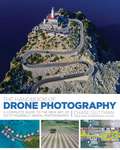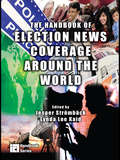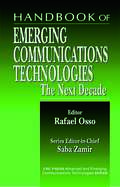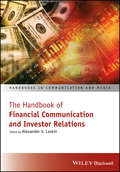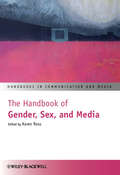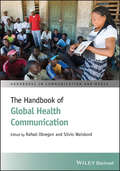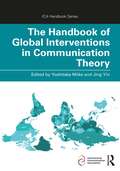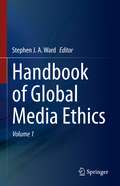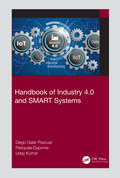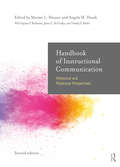- Table View
- List View
Handbook of Communication and Social Interaction Skills (Routledge Communication Series)
by JOHN O. GREENE; BRANT R. BURLESONProviding a thorough review and synthesis of work on communication skills and skill enhancement, this Handbook serves as a comprehensive and contemporary survey of theory and research on social interaction skills. Editors John O. Greene and Brant R. Burleson have brought together preeminent researchers and writers to contribute to this volume, establishing a foundation on which future study and research will build. The handbook chapters are organized into five major units: general theoretical and methodological issues (models of skill acquisition, methods of skill assessment); fundamental interaction skills (both transfunctional and transcontextual); function-focused skills (informing, persuading, supporting); skills used in management of diverse personal relationships (friendships, romances, marriages); and skills used in varied venues of public and professional life (managing leading, teaching). Distinctive features of this handbook include:* broad, comprehensive treatment of work on social interaction skills and skill acquisition;* up-to-date reviews of research in each area; and* emphasis on empirically supported strategies for developing and enhancing specific skills.Researchers in communication studies, psychology, family studies, business management, and related areas will find this volume a comprehensive, authoritative source on communications skills and their enhancement, and it will be essential reading for scholars and students across the spectrum of disciplines studying social interaction.
The Handbook of Communication Engagement (Handbooks in Communication and Media)
by Kim A. Johnston Maureen TaylorA comprehensive volume that offers the most current thinking on the practice and theory of engagement With contributions from an international panel of leaders representing diverse academic and professional fields The Handbook of Communication Engagement brings together in one volume writings on both the theory and practice of engagement in today’s organizations and societies. The expert contributors explore the philosophical, theoretical, and applied concepts of communication engagement as it pertains to building interaction and connections in a globalized, networked society. The Handbook of Communication Engagement is comprehensive in scope with case studies of engagement from various disciplines including public relations, marketing, advertising, employee relations, education, public diplomacy, and politics. The authors advance the current thinking in engagement theory, strategy, and practice and provide a review of foundational and emerging research in engagement topics. The Handbook of Communication Engagement is an important text that: Provides an overview of the foundations and philosophies of engagement Identifies the contexts of engagement relating to specific areas across government and corporations, including CSR, consumer, activism, diplomacy, digital, and social impact Includes examples of contemporary engagement practice Presents applications of engagement and technology Offers insights on the future directions of engagement The Handbook of Communication Engagement offers an essential reference for advanced undergraduate, graduate students, practitioners and scholars from communication, media, advertising, public relations, public policy, and public diplomacy areas. The volume contains a compendium of the writings on the most recent advances on the theory and practice of engagement. Winner of the 2018 PRIDE Award for Innovation, Development, and Educational Achievement from the Public Relations Division of the National Communication Association.
The Handbook of Communication Ethics (ICA Handbook Series)
by George CheneyThe Handbook of Communication Ethics serves as a comprehensive guide to the study of communication and ethics. It brings together analyses and applications based on recognized ethical theories as well as those outside the traditional domain of ethics but which engage important questions of power, equality, and justice. The work herein encourages readers to make important connections between matters of social justice and ethical theory. This volume makes an unparalleled contribution to the literature of communication studies, through consolidating knowledge about the multiple relationships between communication and ethics; by systematically treating areas of application; and by introducing explicit and implicit examinations of communication ethics to one another. The Handbook takes an international approach, analyzing diverse cultural contexts and comparative assessments. The chapters in this volume cover a wide range of theoretical perspectives on communication and ethics, including feminist, postmodern and postcolonial; engage with communication contexts such as interpersonal and small group communication, journalism, new media, visual communication, public relations, and marketing; and explore contemporary issues such as democracy, religion, secularism, the environment, trade, law, and economics. The chapters also consider the dialectical tensions between theory and practice; academic and popular discourses; universalism and particularism; the global and the local; and rationality and emotion. An invaluable resource for scholars in communication and related disciplines, the Handbook also serves as a main point of reference in graduate and upper-division undergraduate courses in communication and ethics. It stands as an exceptionally comprehensive resource for the study of communication and ethics.
The Handbook of Communication Ethics (ICA Handbook Series)
by Amit Pinchevski Patrice M. Buzzanell Jason HannanThe second edition of this handbook offers a thoroughly updated overview of the different approaches and perspectives in communication ethics today.Extending the path paved by its predecessor, this handbook includes new issues and concerns that have emerged in the interim—from environmentalism to artificial intelligence, from disability studies to fake news. It also features a new structure, comprised of three sections representing a wide array of communication ethics: traditions, contexts, and debates. Rather than focusing exclusively on a subset of ethics (such as interpersonal communication, rhetoric, or journalism, as do other handbooks of ethics in communication), this collection provides a valuable resource for those who seek a broader basis on which to study communication ethics.This handbook is a must-read for faculty, graduate students, and advanced undergraduate students in all areas of communication studies, as well as in neighboring disciplines such as rhetoric, media studies, sociology, political science, cultural studies, and science and technology studies.
The Handbook of Communication History (ICA Handbook Series)
by Jr. Janice Peck Peter Simonson Robert T. Craig John P. JacksonThe Handbook of Communication History addresses central ideas, social practices, and media of communication as they have developed across time, cultures, and world geographical regions. It attends to both the varieties of communication in world history and the historical investigation of those forms in communication and media studies. The Handbook editors view communication as encompassing patterns, processes, and performances of social interaction, symbolic production, material exchange, institutional formation, social praxis, and discourse. As such, the history of communication cuts across social, cultural, intellectual, political, technological, institutional, and economic history. The volume examines the history of communication history; the history of ideas of communication; the history of communication media; and the history of the field of communication. Readers will explore the history of the object under consideration (relevant practices, media, and ideas), review its manifestations in different regions and cultures (comparative dimensions), and orient toward current thinking and historical research on the topic (current state of the field). As a whole, the volume gathers disparate strands of communication history into one volume, offering an accessible and panoramic view of the development of communication over time and geographical places, and providing a catalyst to further work in communication history.
The Handbook of Communication in Cross-cultural Perspective (ICA Handbook Series)
by Donal CarbaughThis handbook brings together 26 ethnographic research reports from around the world about communication. The studies explore 13 languages from 17 countries across 6 continents. Together, the studies examine, through cultural analyses, communication practices in cross-cultural perspective. In doing so, and as a global community of scholars, the studies explore the diversity in ways communication is understood around the world, examine specific cultural traditions in the study of communication, and thus inform readers about the range of ways communication is understood around the world. Some of the communication practices explored include complaining, hate speech, irreverence, respect, and uses of the mobile phone. The focus of the handbook, however, is dual in that it brings into view both communication as an academic discipline and its use to unveil culturally situated practices. By attending to communication in these ways, as a discipline and a specific practice, the handbook is focused on, and will be an authoritative resource for understanding communication in cross-cultural perspective. Designed at the nexus of various intellectual traditions such as the ethnography of communication, linguistic ethnography, and cultural approaches to discourse, the handbook employs, then, a general approach which, when used, understands communication in its particular cultural scenes and communities.
The Handbook of Communication Science
by Charles R. Berger Michael E. Roloff David R. EwoldsenThis revision of a classic volume presents state-of-the-art reviews of established and emerging areas of communication science and provides an intellectual compass that points the way to future theorizing about communication processes. In this Second Edition of The Handbook of Communication Science, editors Charles R. Berger, Michael E. Roloff, and David Roskos-Ewoldsen bring together an impressive array of communication scholars to explore and synthesize the varying perspectives and approaches within the dynamic field of communication science. After first addressing the methods of research and the history of the field, the Handbook then examines the levels of analysis in communication (individual to macro-social), the functions of communication (such as socialization and persuasion), and the contexts in which communication occurs (such as couples, families, organizations, and mass media). Key Features: Draws on the scholarship and expertise of leading communication scholars who explore different aspects of the field Covers all facets of communication science, from the historical and theoretical to the practical and applied Covers the latest theoretical developments in the field, as well as alternative methodologies and levels of analysis Explores key communication contexts of the 21st century, including interpersonal dimensions of health communication, the scientific investigation of marital and family communication, and computer-mediated communication Includes incisive analyses, literature reviews, bibliographies, and suggestions for future research The Handbook of Communication Science, Second Edition, is an essential reference resource for scholars, practitioners, and students. It is appropriate for upper-level undergraduate or graduate courses in Communication and Media Studies and Mass Communication.
The Handbook of Communication Science and Biology (ICA Handbook Series)
by Kory Floyd René WeberThe Handbook of Communication Science and Biology charts the state of the art in the field, describing relevant areas of communication studies where a biological approach has been successfully applied. The book synthesizes theoretical and empirical development in this area thus far and proposes a roadmap for future research. As the biological approach to understanding communication has grown, one challenge has been the separate evolution of research focused on media use and effects and research focused on interpersonal and organizational communication, often with little intellectual conversation between the two areas. The Handbook of Communication Science and Biology is the only book to bridge the gap between media studies and human communication, spurring new work in both areas of focus. With contributions from the field’s foremost scholars around the globe, this unique book serves as a seminal resource for the training of the current and next generation of communication scientists, and will be of particular interest to media and psychology scholars as well.
The Handbook of Communication Training: A Best Practices Framework for Assessing and Developing Competence
by J D Wallace Dennis BeckerCommunication remains a significant topic for job acquisition, development, and advancement. As such, there are no shortage of classes, seminars and books written on the subject. However, there are few designed for the corporate consultant that are not aligned with some proprietary system, traditional academic classrooms, or author’s speculation. These tend to be either inaccessible, questionable in their content, or specifically aligned with the producers’ interests. So where can the Communication trainers and consultants go to focus on fundamental touchstone research and practices? The Handbook of Communication Training is a powerful template, and first of its kind, for communication practitioners and academicians who wish to strengthen their professional capabilities. It also acts as a guide and standard for consumers and clients of these services. The chapters within are an outgrowth of the National Communication Association’s Training & Development Division’s desire to provide guidance, structure, and support for members and non-members alike. It is specifically targeted at those pursuing best practices regarding communication consulting, coaching, teaching and training. The 7 Best Practices presented in this book represent capabilities that are foundational to the effective transfer of communication promotion and skill enhancement. As such, these practices, and supporting chapters, should appeal to novice and experts alike.
The Handbook of Comparative Communication Research (ICA Handbook Series)
by Frank Esser Thomas HanitzschThe Handbook of Comparative Communication Research aims to provide a comprehensive understanding of comparative communication research. It fills an obvious gap in the literature and offers an extensive and interdisciplinary discussion of the general approach of comparative research, its prospect and problems as well as its applications in crucial sub-fields of communications. The first part of the volume charts the state of the art in the field; the second section introduces relevant areas of communication studies where the comparative approach has been successfully applied in recent years; the third part offers an analytical review of conceptual and methodological issues; and the last section proposes a roadmap for future research.
The Handbook of Conversation Analysis
by Jack Sidnell Tanya StiversPresenting a comprehensive, state-of-the-art overview of theoretical and descriptive research in the field, The Handbook of Conversation Analysis brings together contributions by leading international experts to provide an invaluable information resource and reference for scholars of social interaction across the areas of conversation analysis, discourse analysis, linguistic anthropology, interpersonal communication, discursive psychology and sociolinguistics. Ideal as an introduction to the field for upper level undergraduates and as an in-depth review of the latest developments for graduate level students and established scholarsFive sections outline the history and theory, methods, fundamental concepts, and core contexts in the study of conversation, as well as topics central to conversation analysisWritten by international conversation analysis experts, the book covers a wide range of topics and disciplines, from reviewing underlying structures of conversation, to describing conversation analysis' relationship to anthropology, communication, linguistics, psychology, and sociology
A Handbook of Corporate Communication and Public Relations: Pure And Applied
by Sandra M. OliverA bold addition to existing literature, this book provides an excellent overview of corporate communication. Taking an interdisciplinary approach, it offers readers the in-depth analysis required to truly understand corporate communication, corporate strategy and corporate affairs as well as the relevant public relations issues.With a refreshing ne
The Handbook of Crisis Communication
by Sherry J. Holladay W. Timothy CoombsWritten as a tool for both researchers and communication managers, the Handbook of Crisis Communication is a comprehensive examination of the latest research, methods, and critical issues in crisis communication. Includes in-depth analyses of well-known case studies in crisis communication, from terrorist attacks to Hurricane KatrinaExplores the key emerging areas of new technology and global crisis communicationProvides a starting point for developing crisis communication as a distinctive field research rather than as a sub-discipline of public relations or corporate communication
The Handbook of Critical Intercultural Communication (Handbooks in Communication and Media)
by Thomas K. Nakayama Rona Tamiko HalualaniAn up-to-date and comprehensive resource for scholars and students of critical intercultural communication studies In the newly revised second edition of The Handbook of Critical Intercultural Communication, a lineup of outstanding critical researchers delivers a one-stop collection of contemporary and relevant readings that define, delineate, and inhabit what it means to ‘do critical intercultural communication.’ In this handbook, you will uncover the latest research and contributions from leading scholars in the field, covering core theoretical, methodological, and applied works that give shape to the arena of critical intercultural communication studies. The handbook's contents scaffold up from historical revisitings to theorizings to inquiry and methodologies and critical projects and applications. This work invites readers to deeply immerse themselves in and reflect upon the thematic threads shared within and across each chapter. Readers will also find: Newly included instructors' resources, including reading assignments, discussion guides, exercises, and syllabi Current and state-of-the-art essays introducing the book and delineating each section Brand-new sections on critical inquiry practices and methodologies and contemporary critical intercultural projects and topics such as settler colonialism, intersectionalities, queerness, race, identities, critical intercultural pedagogy, migration, ecologies, critical futures, and more Perfect for scholars, researchers, and students of intercultural communication, intercultural studies, critical communication, and critical cultural studies, The Handbook of Critical Intercultural Communication, 2nd edition, stands as the premier resource for anyone interested in the dynamic and ever evolving field of study and praxis: critical intercultural communication studies.
Handbook of Digital Journalism: Perspectives from South Asia
by Surbhi Dahiya Kulveen TrehanThis book presents perspectives from South Asian countries, such as India, Nepal, Sri Lanka, Bangladesh, and Bhutan. It brings in-depth perspectives on content, communication, and community between communication theory and the digital news ecosystem rooted in a South Asian culture-centric approach. The book thoroughly investigates changes in the regulatory framework, regulations, policies, and code of conduct. It engages debates on digital journalism practices modeled around mobile journalism, immersive storytelling, and gamification in the context of local and hyper-local communities in South Asia. The book provides a cohesive compilation offering readers an up-to-date and comprehensive understanding of digital developments in journalism. It also helps journalists and practitioners working in news media to discover new types of information flows in a rapidly changing news media landscape.Digital Journalism: Perspectives from South Asia is a descriptive, exploratory book on digital journalism practices and policies followed in India, Nepal, Sri Lanka, Bangladesh, and Bhutan. It brings in-depth perspectives on content, communication, and community between communication theory and the digital news ecosystem rooted in a South Asia. What makes this book interesting to read is the integration of forms with manifestations on ground intersecting identities and ideologies. The book thoroughly investigates changes in the regulatory framework, regulations, policies, and code of conduct. Various chapters in the book pursue significant and exciting topics on the changing spaces of news production and consumption, the inter relationship between old and new media, everyday digital news usage and engagement, social media for news, revenue models for digital journalism among others. The highlight of this book is engaging debates on digital journalism practices modeled around mobile journalism, immersive storytelling, gamification, in the context of local and hyper local communities in South Asia. Since Digital Journalism draws extensively from algorithms, matrices and analytics, this book has exclusive chapters on data journalism, data visualization and big data.. The book provides a cohesive compilation offering readers an up-to-date and comprehensive understanding of digital developments in journalism. It also helps journalists and practitioners working in news media to discover new types of information flows in a rapidly changing news media landscape. It also articulates indegenous concerns of journalists, their security, risks and challenges as they explore the new contours of journalistic practices.
The Handbook of Drone Photography: A Complete Guide to the New Art of Do-It-Yourself Aerial Photography
by Chase GuttmanDrones are the next frontier in photography. This cutting-edge technology, still unexplored by the masses, can bring visual artistry to new and exciting heights. The Handbook of Drone Photography will be the go-to manual for consumers wishing to harness the power of drones to capture stunning aerial photographs.This book covers everything one needs to choose the right drone, to get airborne, and to capture and share incredible content. With easy and straightforward instruction, the text will familiarize readers with their craft and its controls. Readers will master drones’ extraordinary image-capturing capabilities and review detailed photography tips that can bring their artistic vision to life. For the first time, aerial photography is open to everyone, and award-winning travel photographer Chase Guttman will guide readers’ drone ventures from beginning to end. The Handbook of Drone Photography can help anyone break into this thrilling, high-potential space and launch their own lofty explorations today.
The Handbook of Election News Coverage Around the World (ICA Handbook Series)
by Jesper Strömbäck Lynda Lee KaidThe Handbook of Election Coverage Around the World focuses on the news coverage of national elections in democracies around the globe. It brings together and compares election news coverage within a single framework, offering a systematic consideration of various factors. Considering the prominence and power of the press in the election process, this volume will offer unique breadth in its global consideration of the topic. The volume will appeal to scholars in political communication, political science, mass media and society, and others studying elections and media coverage around the world.
Handbook of Emerging Communications Technologies: The Next Decade (Advanced & Emerging Communications Technologies)
by Rafael OssoCommunication technologies change the way we live our lives-the ways we communicate and share information, the news, and our entertainment. The new millennium promises to bring some of the most volatile activity in the history of communications, as we continue to be bombarded by new standards and technologies. The near frenzy of corporate mergers and acquisitions accelerates technological development and can provide hints of what is to come. With the rapid appearance of new protocols, standards, and tools, it becomes increasingly difficult -and increasingly important-for communications professionals to remain up-to-date on new and emerging technologies.The Handbook of Emerging Communications Technologies: The Next Decade fills this gap. Until now, information on many of its topics, such as Multiprotocol over ATM, IP Multicasting, and RSVP, existed only as fragmented articles on the Internet or as complex feature specifications. In this landmark volume, 18 leading authorities each tackle one of the cutting edge technologies destined to shape the future. Each chapterDescribes a technology and any standards on which it is based Discusses its impact on the communications field Forecasts its future directionDeveloped primarily for telecommunications specialists network managers, developers, and analysts, the Handbook of Emerging Communications Technologies: The Next Decade, offers the opportunity to acquire a deeper understanding of future technologies necessary to remaining current, and serves as a valuable reference guide for corporate executives, planners, and information managers-anyone seeking general knowledge about where the communications industry is heading.
The Handbook of Financial Communication and Investor Relations
by Alexander V. LaskinThe first book to offer a global look at the state-of-the-art thinking and practice in investor relations and financial communication Featuring contributions from leading scholars and practitioners in financial communication and related fields--including public relations, corporate communications, finance, and accounting-- this volume in the critically acclaimed "Handbooks in Communication and Media" seriesprovides readers with a comprehensive, up-to-date picture of investor relations and financial communications as they are practiced in North America and around the world. The Handbook of Financial Communication and Investor Relations provides an overview of the past, present, and future of investor relations and financial communications as a profession. It identifies the central issues of contemporary investor relations and financial communications practice, including financial information versus non-financial information, intangibles, risk, value, and growth. Authors address key topics of concern to contemporary practitioners, such as socially responsible investing, corporate governance, shareholder activism, ethics, and professionalism. In addition, the book arms readers with metrics and proven techniques for reliably measuring and evaluating the effectiveness of investor relations and financial communications. Bringing together the most up-to-date research on investor relations and financial communication and the insights and expertise of an all-star team of practitioners, The Handbook of Financial Communication and Investor Relations: Explores how the profession is practiced in various regions of the globe, including North America, South America, Europe, the Middle East, India, Australia, and other areas Provides a unique look at financial communication as it is practiced beyond the corporate world, including in families, the medical profession, government, and the not-for-profit sector Addresses "big-picture" strategies as well as specific tactics for financial communication during crises, the use of social media, dealing with shareholder activism, integrated reporting and CSR, and more This book makes an ideal reference resource for undergrads and graduate students, scholars, and practitioners studying or researching investor relations and financial communication across schools of communication, journalism, business, and management. It also offers professionals an up-to-date, uniquely holistic look at best practices in financial communication investor relations worldwide.
The Handbook of Gender, Sex, and Media (Handbooks in Communication and Media #24)
by Karen RossThe Handbook of Gender, Sex and Media offers original insights into the complex set of relations which exist between gender, sex, sexualities and the media, and in doing so, showcases new research at the forefront of media and communication practice and theory. Brings together a collection of new, cutting-edge research exploring a number of different facets of the broad relationship between gender and media Moves beyond associating gender with man/woman and instead considers the relationship between the construction of gender norms, biological sex and the mediation of sex and sexuality Offers genuinely new insights into the complicated and complex set of relations which exist between gender, sex, sexualities and the media Essay topics range from the continuing sexism of TV advertising to ways in which the internet is facilitating the (re)invention of our sexual selves.
The Handbook of Global Health Communication (Handbooks in Communication and Media #29)
by Rafael Obregon Silvio WaisbordInternational in scope, The Handbook of Global Health Communication offers a comprehensive and up-to-date analysis of the role of communication processes in global public health, development and social change Brings together 32 contributions from well-respected scholars and practitioners in the field, addressing a wide range of communication approaches in current global health programs Offers an integrated view that links communication to the strengthening of health services, the involvement of affected communities in shaping health policies and improving care, and the empowerment of citizens in making decisions about health Adopts a broad understanding of communication that goes beyond conventional divisions between informational and participatory approaches
The Handbook of Global Interventions in Communication Theory (ICA Handbook Series)
by Yoshitaka MiikeMoving beyond the U.S.-Eurocentric paradigm of communication theory, this handbook broadens the intellectual horizons of the discipline by highlighting underrepresented, especially non-Western, theorists and theories, and identifies key issues and challenges for future scholarship. Showcasing diverse perspectives, the handbook facilitates active engagement in different cultural traditions and theoretical orientations that are global in scope but local in effect. It begins by exploring past efforts to diversify the field, continuing on to examine theoretical concepts, models, and principles rooted in local cumulative wisdom. It does not limit itself to the mass-interpersonal communication divide, but rather seeks to frame theory as global and inclusive in scope. The book is intended for communication researchers and advanced students, with relevance to scholars with an interest in theory within information science, library science, social and cross-cultural psychology, multicultural education, social justice and social ethics, international relations, development studies, and political science.
Handbook of Global Media Ethics
by Stephen J. A. WardThis handbook is one of the first comprehensive research and teaching tools for the developing area of global media ethics. The advent of new media that is global in reach and impact has created the need for a journalism ethics that is global in principles and aims. For many scholars, teachers and journalists, the existing journalism ethics, e.g. existing codes of ethics, is too parochial and national. It fails to provide adequate normative guidance for a media that is digital, global and practiced by professional and citizen. A global media ethics is being constructed to define what responsible public journalism means for a new global media era. Currently, scholars write texts and codes for global media, teach global media ethics, analyse how global issues should be covered, and gather together at conferences, round tables and meetings. However, the field lacks an authoritative handbook that presents the views of leading thinkers on the most important issues for global media ethics. This handbook is a milestone in the field, and a major contribution to media ethics.
Handbook of Industry 4.0 and SMART Systems
by Uday Kumar Diego Galar Pascual Pasquale DaponteIndustry 4.0 refers to fourth generation of industrial activity characterized by smart systems and internet-based solutions. This book describes the fourth revolution based on instrumented, interconnected and intelligent assets. The different book chapters provide a perspective on technologies and methodologies developed and deployed leading to this concept. With an aim to increase performance, productivity and flexibility, major application area of maintenance through smart system has been discussed in detail. Applicability of 4.0 in transportation, energy and infrastructure is explored, with effects on technology, organisation and operations from a systems perspective.
Handbook of Instructional Communication: Rhetorical and Relational Perspectives
by Marian L. Houser Angela HosekThe Handbook of Instructional Communication offers a comprehensive collection of theory and research focusing on the role and effects of communication in instructional environments. Now in its Second Edition, the handbook covers an up-to-date array of topics that includes social identity, technology, and civility and dissent. This volume demonstrates how to understand, plan, and conduct instructional communication research as well as consult with scholars across the communication discipline. Designed to address the challenges facing educators in traditional and nontraditional settings, this edition features a wealth of in-text resources, including directions for future research, suggested readings, and surveys for instructional assessment.
